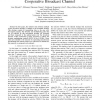Free Online Productivity Tools
i2Speak
i2Symbol
i2OCR
iTex2Img
iWeb2Print
iWeb2Shot
i2Type
iPdf2Split
iPdf2Merge
i2Bopomofo
i2Arabic
i2Style
i2Image
i2PDF
iLatex2Rtf
Sci2ools
PIMRC
2008
IEEE
2008
IEEE
Code construction for the selective TDMA cooperative broadcast channel
—In this paper, the selective time division multiple access (S-TDMA) strategy is studied in the downlink channel. This strategy consists in transmitting data to the user with the largest capacity. The diversity and multiplexing gains that can be achieved by this sub-optimal strategy are evaluated and then compared to the optimal gains over the broadcast channel. Codes construction is then proposed to achieve the diversity multiplexing tradeoff (DMT) of the S-TDMA. These codes are extended to the scenario of cooperating asynchronous broadcasting base stations where new codes that are suitable for this scenario are proposed and analyzed.
Communications | Diversity Multiplexing Tradeoff | PIMRC 2008 | Strategy | Time Division Multiple Access |
| Added | 01 Jun 2010 |
| Updated | 01 Jun 2010 |
| Type | Conference |
| Year | 2008 |
| Where | PIMRC |
| Authors | Lina Mroueh, Mohamed Oussama Damen, Stéphanie Rouquette-Léveil, Ghaya Rekaya-Ben Othman, Jean-Claude Belfiore |
Comments (0)

